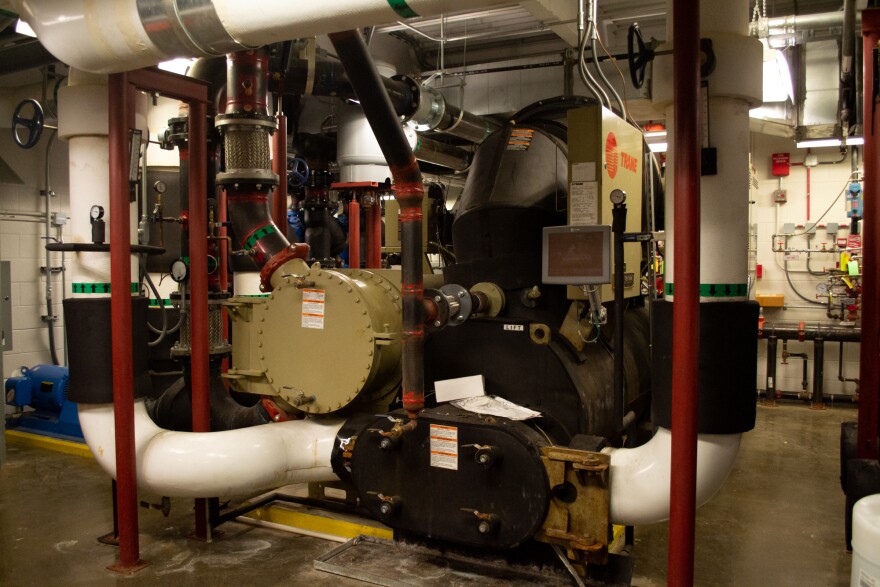Northern Virginia is home to the largest concentration of data centers in the world. A few facilities have also been developed in our neck of the woods, and the industry impacts the entire state's power grid. WMRA's Randi B. Hagi reports.
As the digital footprint of our lives expands, the data center industry grows. So, too, do its demands for the power, water, and land required to run the infrastructure behind the scenes (and screens). "Data alley," as eastern Loudoun County is called, boasts 25 million square feet of data centers. The Shenandoah Valley and central Virginia are home to a few sizable data centers, too – and one smaller facility granted me a tour to see what goes into running a center.
As IBM explains for us technologically impaired, data centers are buildings that house rows upon rows of servers – powerful computers that run and store the internet-based systems that you access from your desktop, laptop, or mobile device. That photo of your dog, backed up to the cloud, and that program you streamed last night, have to live somewhere.
The Virginia Economic Development Partnership lists four companies running data centers in our broadcast region:
- Middletown Data Center, in Frederick County, is a 43,000 square foot facility that offers server space for rent.
- DBT Data has a 102,000 square foot center in Harrisonburg. The industry website Datacenter Dynamics reported last year that the property is leased to insurance provider Anthem Health.
- Lumos Networks, the fiber optics company now known as Segra, is listed as having data centers in the Shenandoah Valley and central Virginia, although I wasn't able to pinpoint where.
- And finally, Equinix has four data centers in Culpeper that it brands as, [quote] "the hub for government and federal agencies." Tax records show each of these four buildings is around 100,000 square feet.

Unfortunately, none of these data centers agreed to do an interview, so to see one in operation, WMRA went to the University of Virginia – where Director Dale Robinson runs the institution's comparatively modest 12,500 square foot facility.
[Door unlocks, opens to the sound of fans whirring]
DALE ROBINSON: The left side, as you enter, from here, all the way to the back, is what we call high performance computing. And then on the right side of the room is standard computing.
Rows of tall metal racks holding the servers are housed within long chambers of insulated glass.

ROBINSON: So, inside there, it's like a refrigerator, and it's enclosed, because you want all of that cold air focused on the computers, going through the machines to cool them off. … Without cooling, this room gets very hot, very fast.
The room is locked and under camera surveillance. Some of the servers are doubly protected behind individually locked racks that even fewer people have access to – they store data like student, faculty, and staff's personal information.
ROBINSON: Another big one, because over the years you have research data with hundreds of personal information for clinical trials, all the patients, so you really have to secure that information.
Giant blue air conditioning units draw the hot air away from the machines and send it downstairs to go through the cooling cycle.
[water rushing]
Outside, water that's absorbed the heat cascades down over metal grates, evaporating and cooling before getting recycled back into the A/C system. A giant pump – I'd estimate it around the size of four Geotrackers – keeps the water circulating.

[machinery hums, beeps]
ROBINSON: So this is all cooling, and that's the big pump system.
HAGI: Wow.
ROBINSON: Looks like something from an aircraft carrier! It is insane!
Data centers require a lot of water to run those cooling systems. For example, according to city records, the 102,000 square foot DBT Data facility in Harrisonburg uses nearly 650,000 gallons of water per month, which is over 100 times the amount an average Virginian household goes through in that same month.

And then there’s the other lifeblood of a data center… electricity.
AARON RUBY: Currently today, data centers across our entire service territory in Virginia consume about as much power as 750,000 homes.
Aaron Ruby is the manager of media relations for Dominion Energy.
RUBY: … and we have forecasted that power demand from data centers is going to nearly quadruple over the next 15 years. … The data centers are certainly the largest power users of any industry, and they represent about 20% of our electricity sales in Virginia. But residential customers as a whole consume more power.
Ruby added that they also expect residential power demand to increase, in part due to consumers converting to electric vehicles and household appliances.
RUBY: So over the next 15 years we're going to be building a lot of new power plants in Virginia, and a lot of new electric transmission infrastructure. … Ninety to 95% of those new power plants will be carbon-free. So that includes offshore wind, that includes solar, battery storage, and next-generation nuclear. About five to 10% of the new power plants we're going to build will be natural gas.
The Virginia Clean Economy Act of 2020 requires the electric grid to transition to 100% clean energy by 2050, and Ruby said Dominion is committed to that goal – but they're not yet sure how to achieve it in the face of increasing demand from homes, data centers, and other customers. The company is researching technologies such as longer-lasting battery storage, small modular nuclear reactors, and hydrogen energy.


